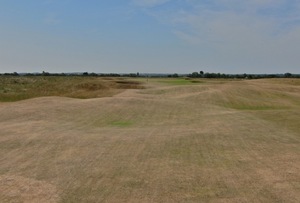When you come to think of it that is the secret of most of the great holes all over the world. They all have some kind of a twist. C.B. MACDONALD
Bubba Has New Knickname; Still Can't Figure Out Links Short Game
/Royal St George's (And Surrounding Scenery) From The Air
/ Thanks to reader Tim for this cool BBC helicopter-shot video of Royal St. George's and the surrounding area, including a great look at the place Viagra was discovered, Royal Cinque Ports and Ian Fleming's house.
Thanks to reader Tim for this cool BBC helicopter-shot video of Royal St. George's and the surrounding area, including a great look at the place Viagra was discovered, Royal Cinque Ports and Ian Fleming's house.Dawson's Theory Validated!*****
/The higher the ball flight, the worse the landing on a fairway hillock, goes Peter Dawson's theory revealed yesterday in a story by John Huggan.
Now Mike Stachura has tracked down a professor who confirms. Fasten your seat belts!
But here's the bit that justifies Dawson's explanation of projectile motion. Basically, a projectile like a golf ball has two velocity components, a horizontal one and a vertical one, as Martin Brouillette, professor of mechanical engineering at the University of Sherbrooke and a member of the Golf Digest Technical Panel explains: "Assuming two cases with the same landing velocity but with different landing angles, the case with the steeper landing angle has a smaller horizontal velocity component, therefore a greater vertical velocity component. This greater vertical velocity component, upon interacting with a tilted landing surface, is more likely to produce a greater sideways velocity component."
Therefore, play the stinger...less sideways velocity component. Oh wait.
***** Stachura writes:
Of course, a ball that's rolling over those awkward angles is going to be dramatically affected; one that's flying by those humps and bumps won't be bothered by them at all.
Maybe we could read more about this theory in the USGA/R&A ball study? After all, we're 8 years in, I assume this theory is covered?
Dawson: Today's Higher Trajectory Means More Extreme Bounces!?
/ The beautiful undulations on the 17th fairway at Royal St. George's. (click to enlarge)John Huggan defends Royal St. George's but shares this peculiar theory of R&A in-house course designer Executive Secretary Peter Dawson, talking about the many harsh bounces found at Sandwich in 2003 and how the R&A has widened out the course since then to address player complaints.
The beautiful undulations on the 17th fairway at Royal St. George's. (click to enlarge)John Huggan defends Royal St. George's but shares this peculiar theory of R&A in-house course designer Executive Secretary Peter Dawson, talking about the many harsh bounces found at Sandwich in 2003 and how the R&A has widened out the course since then to address player complaints.Dawson Can't Get That Jug Away From Louis Fast Enough!
/
"Draw reveals some mouthwatering groups"
/Your First Sandwich Primer
/ The Open at Royal St. George's is upon us and Lawrence Donegan says the place has a lot riding on this week after Ben Curtis' shocking win in 2003.
The Open at Royal St. George's is upon us and Lawrence Donegan says the place has a lot riding on this week after Ben Curtis' shocking win in 2003.Royal St. George's Roughless, On Edge...Already
/ An unbylined BBC report says Royal St. George's is drawing upon emergency water supplies and in general, already super dry after the driest spring in 100 years follows a dry 2010. Like Augusta, this is a course that is better with a lot of turf and conditions not super firm and fast, so look out Open contestants!
An unbylined BBC report says Royal St. George's is drawing upon emergency water supplies and in general, already super dry after the driest spring in 100 years follows a dry 2010. Like Augusta, this is a course that is better with a lot of turf and conditions not super firm and fast, so look out Open contestants!
The lack of rain has put pressure on ground staff at the Kent golf course holding the Open golf tournament in July.
After the driest spring for 100 years staff at Royal St George's Golf Club in Sandwich are having to work round the clock to prepare the course.
Seeing players wading knee deep through the rough looking for stray balls has become a tradition at the Open.
But the lack of rain means the grass has not grown as deep as was hoped for.
Golfers who have been practising over the past few weeks have told ground staff that even if the rough does not come up to the level it should, the course still presents a challenge.
If it still presents a challenge, why have rough at all? Oh sorry, go on...
Christopher Gabbey, club secretary, said: "The rough may be slightly less than we would have wished but then the ground will be firm, the greens will be firm and they will still find it quite difficult.
"A lot depends on the wind we get during the week and the best man will come to the fore."
There has been just over 33mm (1.3in) of rain in Kent between March and May compared to an average of more than 148mm (5.8in).
To help keep the course watered, the club is allowed to draw water from the nearby River Stour. Since March it has taken two and a half million gallons - nearly half its annual allowance.













